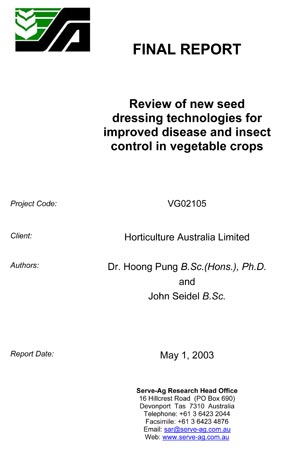|
|
This scoping project was conducted to gauge the interest of the relevant product manufacturers and seed companies in their support and funding for the development and introduction of new products for use in seed dressings in Australia. New and current active ingredients used for seed dressings on vegetable and broad-acre crop seeds in Australia, and overseas were reviewed. Seed dressing is a cost-effective method for disease control on seed and seedlings, applied at a stage when they are most vulnerable to attack by pathogens and insect pests.
Examination of seed treatments registered in Australia and overseas revealed that many of the active ingredients are relatively old chemistry such as benomyl and thiram (originated in 1968 and 1931). In contrast, a wide array of new chemistry is registered in broad-acre crops, including the azoxystrobin, difenconazole, fludioxinil, fluquinconazole, flutriafol, tebuconazole, triadimenol, imidacloprid, thiamethoxam, fipronil and clothianidin (all were introduced from 1990 onwards). In many instances, the use of new systemic seed treatments (new chemistry) has the potential to provide more effective control of many vegetable seed, soil and air-borne diseases and insect pests, compared to old seed treatments. These improvements in new chemistry can potentially help reduce at least one to two pesticide spray applications during the crop growth, and help reduce the overall cost in pesticide use. The greatest potential for improvement in vegetable seed treatment is expected to be from the use of the new class of neonicotinoid insecticides for the control of sucking insect pests (eg aphids and thrips) and for preventing the transmission of plant viruses by these insect vectors. These new insecticides are highly specific insecticide; efficacious only against leaf sucking and feeding insects like aphids and whiteflies. They do not kill on contact, and require ingestion by the insect for control, and hence are compatible with the use of predatory and beneficial insects for integrated pest management. Another potential benefit for the vegetable industry is the packaging of seed treatment by combining several fungicides and/or insecticides for multiple disease and pest control, a practice that is increasingly used on broad-acre crops. Such use in the packaging of seed treatment for combined seed, soil and air-borne pathogen and insect control heralds a new approach to integrating disease and pest management. Even if follow-on post-plant spray application is required for during the crop, the combined use of fungicides and pesticides in seed treatment can help negate the use of pesticide sprays at the early crop establishment stage, thereby reducing the number of foliar spray applications. The authors acknowledge the following people for providing relevant information in this study:
This project has been facilitated by Horticulture Australia Limited, and has been funded by voluntary contributions from Syngenta Crop Protection Pty Ltd. The Australian Government provides matching funding for all of Horticultural Australia’s Research |
||||||||||||||
|

